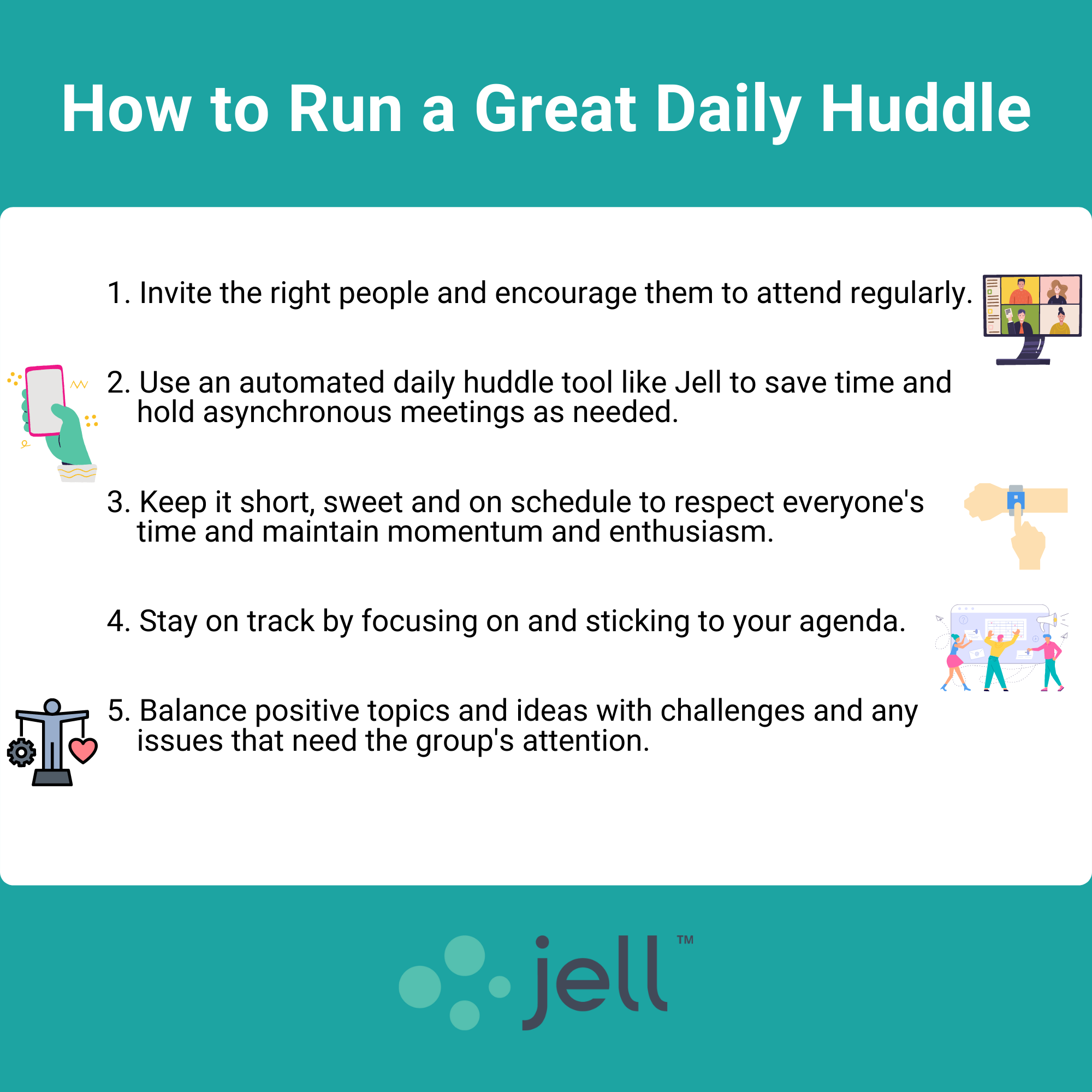You’ve probably heard it before and you’ll probably hear it again, but meeting fatigue is real – both for in-person and remote teams. It can become an all-too-common habit to meet for many small things ad-hoc or to simply schedule too many meetings that go long and off-topic, causing many people to check out when things don’t apply to them. The solution? Something called the daily huddle.
Now, before you click away at the thought of a meeting every day, hold up. These huddles are very short, literally 10-15 minutes. And they work for good reason.
Read on to learn more about this, and:
- what daily huddles are
- why you should meet daily
- how to run a stellar daily huddle
- ways to automate daily huddles
- how to structure your daily huddle
- some common daily huddle FAQs
Make the most of these quick meetings with Jell.
14-day free trial. No credit card required.
Related Articles
Improve Meetings & One-on-Ones With This Employee Check-In Template
The Standup Meeting: Your Ultimate Guide to Knocking it Out of the Park
61 Useful Check-In Questions for Remote Teams
What is a Daily Huddle?
A daily huddle is a quick, pointed, focused team meeting held each day. It gives everyone an opportunity to get on the same page and in sync, establish priorities and share information. The idea behind meeting this frequently is that you’ll see overall improved team member alignment, performance, productivity, communication and engagement.
Why Should My Team Meet for Daily Huddles?
There are many benefits to meeting for daily huddles, such as:
Save hours in miscommunication, ad hoc meetings and wasted time
When you hold huddles each day, you’ll find much less need for other meetings you’re already having, both planned and unplanned. Since you’re covering necessary topics at your huddles on a frequent basis to many people at once, you’ll be more productive and efficient in less time during other meetings. Plus, there’s no need to hang onto information to share days later since your huddles happen daily. This means you’ll get responses quicker, so you can be nimble to change and pivot more easily and quickly than you otherwise would, allowing your team to hit those goals and succeed.
Lead a more connected, cohesive, collaborative team
As your team regularly huddles, you’ll find they’ll have the chance to really get to know, understand and trust one another. Some personal stories and anecdotes will inevitably get intertwined with business, so their connection will deepen and grow. This makes an even bigger impact for team members with very independent or siloed roles – it’s quite possible this is their only meeting all day. Over time, you’ll find you’re managing a more cohesive, efficient team. Even better, if you’re including other departments or groups, you’ll get a natural sense of what’s going on company-wide, too. This means better communication, processes and outcomes, overall.
Be interrupted less and have smoother days
When everyone makes themselves available for a short time each day, you’ll accomplish more and therefore find overall fewer interruptions throughout the day. Whether it’s more emails, chat messages, video or in-person conversations, or (dare I say) meetings, chances are good that whatever it is can wait until the next huddle.
Reduce and correct misinformation
Even though you believe your messaging and instructions are perfectly clear on a regular basis, this isn’t always the case. We’re all human, and it’s normal for each one of us to understand and interpret things differently at times. When you’re frequently checking in with each team member, you have all the more opportunity to identify these potential misunderstandings and nip them in the bud before they become bigger obstacles and time wasters.
How to Run an Effective Daily Huddle

Be thoughtful with who you invite, and make sure they attend regularly
If you need to deal with more immediate specific, detailed issues impacting your team, just include them. If you work for a large company and are hoping to communicate broader-reaching messages to other departments, this will play a role in your list.
Whoever you feel is important to include, plan the meetings at a time that suits everyone – whether that’s first thing in the morning, right before lunch, the day’s end, or at some other point in time. This will encourage regular attendance, making your meetings more impactful and productive.
Keep it short, sweet and on time
Daily huddles should last about 10 or 15 minutes, max. Keeping your meetings on time is important so that you don’t get off track, into deeper topics, problem-solving and conversations that could (and should) happen outside of the daily huddle. After all, you could lose people’s attention when you want them to remain engaged and motivated to keep attending. When you’re running such a short meeting, every minute counts! Remember, the point is to keep it consistent but simple.
Be balanced
There are many positive things about daily huddles – anything from hearing good news and connecting with colleagues to learning of goals being reached. It’s always great to break the ice this way and get everyone in a good frame of mind. Plus, if someone is worried or struggling with something, their outlook can be greatly improved with a little good news. As well, the discipline required to come up with and announce a daily priority really helps people focus and remain accountable.
That said, daily huddles are also an opportune place to share roadblocks and challenges. You can’t help fix what you don’t know is broken, so it’s important to foster an open, safe and supported environment where your team feels comfortable sharing things they need help with.
Stay on course
Your agenda is key to ensuring the group keeps on track and on time, and a focused, engaging facilitator can help with that. This might look like having the team share their priorities for the day, something that’s gone well for them since the day before, and whether they’re facing any challenges.
If you find the discussion veering off course, use it as a chance to point it out and follow up with whoever you need to afterwards to set up another meeting for addressing their points. This ties into documenting what gets discussed, so it’s easy to refer back to later. Assign a notetaker and, better yet, use an automated tool like Jell. Which leads to the next point…
Use an automated daily huddle tool for efficiency
Automated daily huddle tools, like Jell, save you time and are especially great if everyone can’t meet at the same time. This is because they let you send asynchronous daily huddles or standups, individual or team check-ins, and track OKRs. You’ll quickly and easily get the information you need from your team, build a culture of transparent teamwork, see that everyone’s aligned toward shared goals and, ultimately, help every one of your team members achieve more. And, your team will always know what their coworkers are working on, get consistent feedback and credit for their work, improved their productivity and focus and get clear visibility of goals for the team and company.

How to Automate Your Daily Huddles With Jell
Jell is a great tool for daily huddle meetings that make your team more efficient in less time. When you use Jell, you’ll easily be able to:
- Create your schedule, with custom or out-of-the-box settings that work with your team’s availability and time zones as needed. Choose any combination of days each week or dates each month.
- Establish your meeting questions as you need to, with full control. You can choose from various question types like multiple choice, list, text or number. Doing this makes it easier for your team to answer and share details and insights you need to make quality decisions.
- Get the whole team up to speed by instantly adding them to the tool. From there, they’ll get reminders to join daily huddles. When everyone is aligned on work issues and projects, you benefit from open, clear communication and quick turnaround times.
Jell’s features
When you use Jell for your asynchronous daily meetings, you’ll enjoy these features and benefits:
- Daily huddles or standups let you keep a pulse on what your entire team’s working on and what they’re achieving.
- Customized check-in meetings give your team a place to share their high-level progress or detailed metrics.
- Share goals for the long term or OKRs (objectives and key results), track progress and link it to your team’s daily activity.
- Various integrations let you seamlessly use the tools you already know and love, like Slack, GitHub, and others.
It’s so easy to get your whole team started with Jell. Check out this video to learn more:
The best part? It takes no time to get setup.
14-day free trial. No credit card required.
Sample Agenda for a Productive Daily Huddle
By now you know that daily huddles are meant to be short and sweet. So, the agenda simply cannot be long or complex. That said, a targeted, meaningful agenda is still key to running successful meetings with your team. It’s important to create a straightforward daily huddle agenda that touches on just the information you need to cover each day. Daily huddle questions can trigger the conversations you need to have as the starting point for a positive, productive day ahead.
Here’s a sample agenda format you can try:
- Yesterday’s wins. Go around the group to hear something that went well for each person the day before. This helps acknowledge and credit team members who are doing well.
- Today’s priorities. Get aligned with everyone’s top priorities for the day, and shift if any conflicts come up.
- Current or anticipated roadblocks. Address any high-level obstacles the team is facing. Since you’re leading the meeting and can act quickly and transparently, this should be quick. But, if deeper issues come up you’ll need to set aside time later to deal with them individually, outside of the group huddle.
Daily Huddle FAQs
What is a daily huddle?
A daily huddle is a quick, focused team meeting you hold each day. They’re intended to give everyone the chance to get on the same page and in sync, establish priorities and share information. The idea behind meeting this frequently is that you’ll see overall improved team member alignment, performance, productivity, communication and engagement.
Why should I hold daily huddles with my team?
Daily huddles allow you and your team to:
- Save time from miscommunication, ad hoc meetings and unproductive work.
- Be more connected, cohesive, and collaborative.
- Experience fewer interruptions for smoother days.
- Reduce and correct misinformation to make everyone more productive.
Can I hold asynchronous daily huddles?
Absolutey. While it’s ideal for some companies and teams to get everyone meeting live, at the same time, this isn’t always possible or necessarily best practice for all. You can use an automated daily huddle meeting tool like Jell to generate your meeting schedule, create your meeting questions, and get your whole team aligned by easily adding them to the tool so they can join meetings each day.
What should my daily huddle agenda look like?
Your daily huddle agenda should focus on what went well yesterday, the priorities of today, and any current or anticipated challenges or roadblocks.
What are some best practices for daily huddles?
When planning out your daily huddles, keep these tips and tricks in mind:
- Invite the right people and encourage them to attend regularly.
- Use an automated daily huddle tool like Jell. it will help keep everyone on track, on time and engaged.
- Keep meetings short (10-15 minutes) and on schedule, according to your set agenda.
- Balance your agenda with good news, positive wins, and personal stories with daily priorities and any struggles or challenges people are experiencing.
Popular Articles
Increase Team Engagement
Remote Work Productivity – How to Be More Productive At Home
5 Ways Effective Teams Run Daily Slack Standups
Jell makes team meetings fun, productive and fast.



